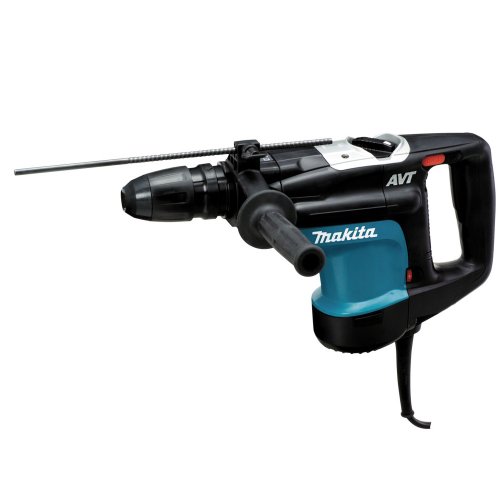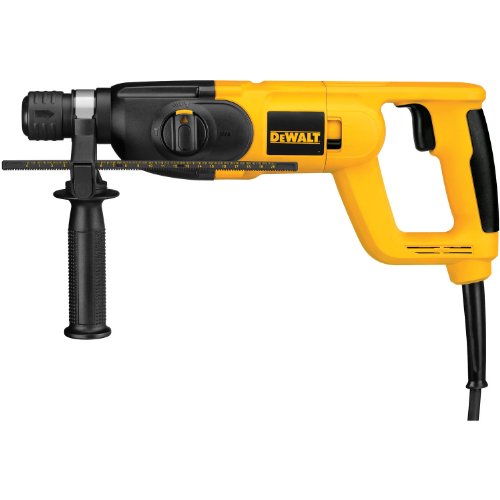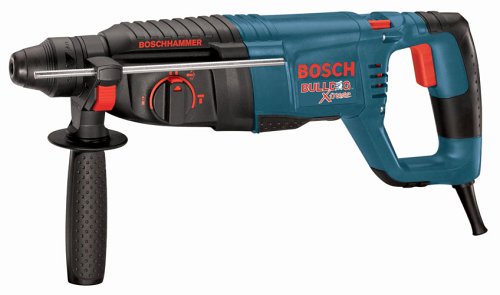Nipping at the heels of the recent release of their 12V MAX power tool line, Dewalt is introducing another platform of remastered and streamlined cordless power tools. Releasing this September, the 20V MAX line is expected to make a considerable splash (for reasons both good and, perhaps, not so good) with the tool community.
Introducing seven innovated power tools and a worklight, Dewalt's 20V MAX line is complete, comprehensive and focused on operator comfort and convenience. This is where the line is expected to make a positive splash. The tools are lightweight, completely ergonomic, and boast an overall impressive battery life. The redesign of the tools' bodies, similar to that of the 12V MAX line, is totally streamlined and with the addition of a few more LED's, operation remains accurate and precise despite less than ideal working conditions. The tool's are well balanced, simple to use, and with some minor speed and power upgrades, the tools are nothing to shake a stick at.
The 20V MAX line, however, deviating from Dewalt's former emphasis on backwards compatibility, is not compatible with their previous 18V platform. This move, despite the re-badging of the new line as 20 volts, has put more than a handful of users in a funk. They feel a little left behind, a little lost in the shuffle, and although Dewalt insists they will maintain the former 18V platform and continue enhancing it (within the limitations of its stem-style battery design), many Dewalt 18V users don't feel as enthusiastic about the 20V platform.
Additionally, and as formerly indicated, the 20V MAX line does not actually produce 20V of working power. In fact, its power output is no different from Dewalt's previous 18V line. The platform is tagged with 20V (rather than 18V) only to avoid compatibility confusion.
Now, after those technicalities are in the open, lets talk a little more about what, specifically, comes along with these tools.
The DRILL-DRIVER:
Beginning with certainly the most popular type of power tool, Dewalt's 20V drill-driver comes in two slightly different versions. The DCD780C2 compact drill-driver kit (with a 1.5-Ah battery) and the DCD980L2 premium drill-driver kit (with a 3.0-Ah battery, slightly larger than the 1.5). Additionally, the hammerdrill-driver and impact driver also come in these slightly distinct versions, but, I (kind of) digress.
Anyhow, the DCD780C2 compact drill-driver kit boasts a super sleek and compact design ideal for working in tight spaces or for use during extended applications. The tool weighs just a measly 3.4-lbs but despite that compact design, the tool's a high-speed, 2-speed transmission (0-600 / 0-2,000 RPM) ensures the drill-driver still packs a considerable punch. The tool is obviously comfortable to use and simple to operate, and with a heavy-duty 1/2" ratcheting chuck it provides good bit gripping strength as well. The thing has 15 clutch settings and the kit includes two 20V MAX lithium ion batteries, a 30-minute fast charger, belt hook, on-board bit holder, a kit box, and a 3-year limited warranty (on the tool only).
On another hand, the DCD980L2 premium drill-driver kit weighs 5.2-lbs but still produces a surprising amount of power from a sleek and comfortable package. The 3.0-Ah battery life is impressive and the batteries themselves contribute to the overall well balance of the tool (of course, the same is true of the other tools in this line-up). The tool's 3-speed all-metal transmission additionally enhances those long run-times and, through matching the tool's output to each application, the general high-performance of the tool as well. With three integrated LED lights, the tool eliminates shadows while working and because the drill has a heavy-duty ratcheting chuck (with carbide inserts for improved gripping strength) and a high-efficiency motor, the driver's power and performance are always reliable. Max RPM is 0-575 / 0-1,350 / 0-2,000 and the clutch has 22 individual settings. The kit includes a one-hour charger, two 20V MAX batteries, a 360-degree side handle, kit box, a 90-day money back guarantee, a 1-year free service contract, and a 3-year limited warranty (on both the battery and the tool).
HAMMERDRILL-DRIVER
To continue, Dewalt's DCD785C2 compact hammerdrill-driver kit (1.5-Ah), at only 3.5-lbs is similarly compact. Its high-speed, 2-speed transmission boasts 0-600 / 0-2,000 RPM for impressive performance in a variety of applications, and because the tool is ergonomically designed and seriously comfortable to use, its working range is nearly unlimited. Like the above drill-driver, this hammerdrill-driver's heavy-duty 1/2" ratcheting chuck has carbide inserts to ensure better bit gripping strength. The kit includes two 20V MAX batteries, a fast charger, belt hook, bit holder, and kit box and the tool itself (just the tool) comes with a three year limited warranty.
The DCD985L2 premium hammerdrill-driver kit boasts the same battery benefits, the same durable 3-speed transmission, the same super-gripping chuck, three LEDs, and the same high-efficiency motor as the premium drill-driver above (DCD980L2). The thing also weighs just 5.2-lbs, but despite its light weight the tool is durable and appears very well equip to take a real jobsite beating. The thing also features the same ergonomic and power benefits as the above hammerdrill-driver and delivers a max RPM range of 0-575 / 0-1,350 / 0-2,000, and a max BPM is 0-9,775 / 0-22,950 / 0-34,000. The hammer-drill-driver kit additionally offers the same inclusions and and comprehensive warranty as the premium drill-driver kit.
IMPACT DRIVER:
Weighing only 2.8-lbs, Dewalt's DCF885C2 compact 1/4" impact driver kit (1.5-Ah) is ideal for working in tight or awkward spaces. Because the thing weighs so little and boasts that ergonomically advanced body design, this impact driver is extremely comfortable to use. The tool has three integrated LED lights to keep your environment illuminated and its one-handed loading ¼" hex chuck (accepts 1" bit tips) renders the tool as convenient as is it powerful. The thing boasts 2,800 RPM, 3,200 IPM and has a max torque of 1,400-in/lbs (117-ft/lbs). The kit includes two 20V lithium ion battery packs, a fast charger, belt hook, kit box and Dewalt's comprehensive 3-year limited warranty, 90-day guarantee, and 1-year free service contract.
Moving forward, the DCF885L2 1/4" impact driver kit (3.0-Ah) weighs 3.4-lbs and with the same three LED lights and similar ergonomic design, this tool is also ideal for close-quarter applications. The tool is comfortable to operate and maintains big power throughout any degree of working difficulty. The same one-handed loading 1/4" hex chuck (accepts 1" bit tips) enhances the tool's overall convenient operation, and with the same 1,400-in/lbs (117-ft/lbs) of max torque, a no load speed of 2,800 RPM, an impressive 3,200 IPM, and the 3.0-Ah 20V MAX battery power, the tool is aggressively powerful and precise. The tool boasts the same inclusions and comprehensive warranty as the above kit.
ANGLE DRILL:
The DCD740C1 compact angle drill kit (1.5-Ah), of course, is designed to make your awkward moments on the job a little simpler to bear. Where a space is tool small, too tight, or in any other capacity, too awkward, the right angle drill is your go-to pal. This particular model is designed with enviable compactness, and with two speed ranges (0-650 / 0-2,000 RPM) the tool is flexible and powerful enough to be in your corner (pardon the pun) for a huge range of applications. The tool's multi-grip trigger also enhances your overall ergonomics and allow users to comfortably operate the tool in a variety of positions. The tool's front-to-back length is just 4", it weighs only 3.8-lbs, uses a plastic 3/8" ratcheting chuck and includes a 30-minute fast charger, a 20V MAX li-ion battery, a belt hook, 2" Phillips tip bit and a kit box. This tool also includes the comprehensive warranty and guarantee listed above.
RECIPROCATING SAW:
Dewalt's DCS380L1 reciprocating saw kit (3.0-Ah) is a pretty brutal little machine. Despite weighing only 7.35-lbs the tool boasts 0 - 3,000 SPM (strokes per minute).This enhances blade control and, of course, contributes to overall faster, smoother cuts. A 1-1/8" stroke length also produces faster, simpler cuts, and with a pivoting adjustable shoe, users have more control over cut depth and glean a little more life from their blades. The saw's four-position blade clamp allows for tool-free blade changes, flush-cutting and also provides increased positional versatility on the job. The saw means business, but is comfortable to operate and durable throughout rough applications. The thing has an electric brake and includes a fast charger, a 20V MAX Lithium Ion battery, a kit box, and the same fancy warranty (3-years with the above satisfaction guarantee and 1-year service contract).
CIRCULAR SAW:
Furthermore, the DCS391L1 (6-1/2") circular saw kit (3.0-Ah) is, not surprisingly, as powerful as it is compact. The saw's 3,700 RPM motor produces industrial speed and power to cut through the most demanding applications and with a crazy-strong (lightweight) magnesium shoe, the saw also provides long-term accuracy. The tool is perfectly balanced, comfortable to operate, has a 0 - 50-degree bevel capacity and weighs only 8-lbs. The saw has a cut depth of 1-5/8" at 45-degrees and 2-1/4" at 90-degrees. Additionally, the circ saw kit includes a fast-charger, a 20V MAX Lithium Ion battery, 6-1/2" carbide-tipped blade, a kit box and the comprehensive warranty (above).
ROTARY HAMMER:
Dewalt's DCH213L2 3-mode SDS rotary hammer kit (3.0-Ah) is quite unlike other rotary hammers of its class. The thing utilizes SHOCKS Active Vibration Control which both considerably reduces vibration and enhances user control, comfort and productivity during even rigorous use. The tool also provides a 360-degree side handle for optimal control and simpler use during more difficult or awkward applications. The hammer offers 1.7-ft/lbs of impact energy rendering the tool just as powerful as any corded hammer (with the added convenience of cordless technology, of course) and with a variable speed and reversing switch, the tool is versatile and well prepared for a variety of applications. The tool's compact, L-shaped design can still access tight spaces with optimal balance, the thing weighs just 6.4-lbs, offers 0-1,100 RPM, and 0-4,100 BPM. The kit includes a one-hour charger, two batteries, depth rod, a kit box and offers the same comprehensive warranty as the above saw.
WORKLIGHT:
And last, but certainly not least, the worklight. Dewalt's DCL040 worklight delivers a super-bright LED output of 110 Lumens. This ensures your work environments are well lit and shadowless for optimal precision, accuracy and overall productivity. The light also has an integral hook for convenient hands-free use as well as use in multiple placements. The head of the light rotates 120-degrees for for optimal functionality and despite the bright output of the light, the thing produces very little heat ensuring both your safety and comfort on the job while still brightening your work-scapes. The tool weighs just 1-lb and with 11-hours of run-time and the same comprehensive warranty (3-years, 1-year service, 90-day guarantee), the thing has seriously got you covered - or, perhaps, simply enlightened.
Good Bargain Filter Aquasana Saving Recumbent Bike Exercise Schecter S1 Buy Now




